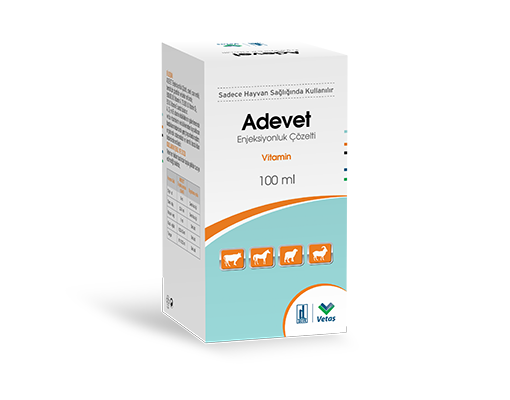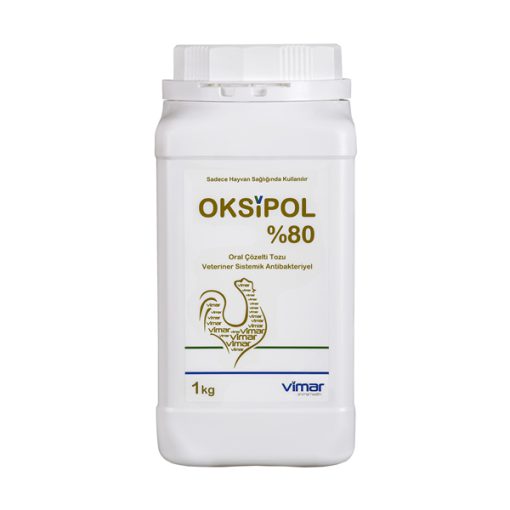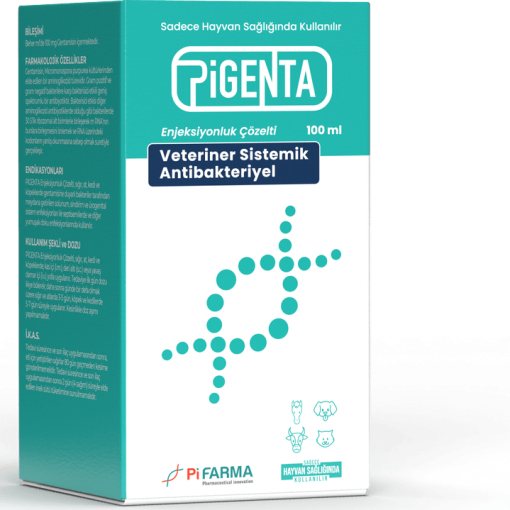For Animal Use Only
PİLOSİN
Solution for Injection
Veterinary Systemic Antibacterial
COMPOSITION
Pilosin Solution for Injection is a light yellow – yellow-colored, clear sterile solution containing 200 mg of Tylosin base per ml.
PHARMACOLOGICAL PROPERTIES
Tylosin is a macrolide antibiotic obtained from Streptomyces fradiae cultures. The drug shows its effect in bacteria by binding to 50S ribosomal subunits and inhibiting protein synthesis. Here it inhibits the binding of peptidyl-t-RNA. The drug acts by stopping the growth of bacteria. Tylosine is mainly susceptible to gram-positive bacteria. The MIC of the drug in susceptible bacteria ranges between 0.1-0.5 µg/ml. Tylosine is mainly susceptible to gram-positive bacteria. Mycoplasma sp., Leptospira sp., Erysipelothrix rhusiopathiae, Treponema hyodisantriae, Corynebacterium pyogenes, Actinomyces sp., Clostridium sp., Chlamydia sp., Fusobacterium necrophorum, Pasteurella sp., Campylobacter sp. are the main susceptible species.
Nocardia sp., Pseudomonas sp., Chlamydia psittaci, Mycobacterium sp., Enterobacteriaceae, B.fragilis, E.coli, and Klebsiella sp. are resistant.
When tylosin is administered intramuscularly and subcutaneously in its base form, it is rapidly absorbed from the application site. It reaches its peak level in plasma 30 minutes after administration at a dose of 10 mg/kg in dogs. It is rapidly absorbed following intramuscular administration in cattle and pigs and reaches peak plasma concentration within 1-2 hours after injection. The mean drug concentration in plasma approximately 2 hours after intramuscular administration is 1.5 mcg/ml, and its half-life is 3-4 hours. The drug that passes into the circulation passes to all body parts except CSF at a concentration that can be effective. The drug concentration in milk can be up to 5 times that in plasma. Tylosin does not change much in the body and is excreted mainly in the bile, milk and partly in the urine.
AREA OF USE/INDICATIONS
Pilosin Solution for Injection is used for respiratory, digestive system and soft tissue infections, especially pneumonia, metritis, pyoderma, early mastitis and agalaxia, pododermatitis, diphtheria, dysentery, arthritis, enteritis, goat liver pain in cattle, sheep and goats caused by bacteria sensitive to Tylosine. It is used in the treatment of secondary bacterial diseases associated with leptospirosis and viral diseases.
USAGE AND DOSAGE
Unless recommended otherwise by the veterinarian, in cattle, sheep and goats administered intramuscularly
Pharmacological Dose: 10 mg/kg b.w./day.
Practical Dose: 1 ml per 20 kg body weight and administered intramuscularly. 5-6 days are sufficient for treatment. More than 10 ml in cattle and 5 ml in sheep and goats should not be administered at the same injection site.
UNDESIRED EFFECTS
It is not recommended for use in horses as it may cause severe shoots. Subcutaneous application may cause painful irritation and local edema. Intramuscular administration may cause local reactions such as necrosis and hemorrhage, and some local reactions in the newly formed conjunctiva 6 days after administration. In some severe cases, petechiae may be observed in the skin and serous membranes. It can cause tachypnea in cattle. Vomiting may occur rarely in cats and dogs.
DRUG INTERACTIONS
Since it binds to the same point in ribosomal proteins, it may interact negatively with lincosamides and chloramphenicol, therefore it should not be used together. It interacts with drugs such as theophylline, digoxin, warfarin, cand yclosporine. Pilosin should not be mixed with other parenteral solutions as it may cause precipitation of the active substance.
SYMTOMS OF OVERDOSE, PRECAUTIONS AND ANTIDOTE
When used in excessively high doses and for a long time, symptomatic treatment should be performed according to the clinical picture that may occur. Epinephrine and oxygen may be required to support respiration in the formation of an anaphylactic picture. In case of overdose, the administration of the drug should be stopped immediately.
RESIDUAL WARNINGS FOR FOOD PRODUCING ANIMALS
Drug Residue Elimination Period: During the treatment and after the last drug application, cattle, sheep, and goats raised for meat should not be sent to slaughter until 28 days after. Cow, sheep, and goat milk obtained for 4 days (8 milkings) during the treatment and after the last drug administration should not be offered for human consumption.
CONTRAINDICATIONS
Tylosin should not be administered orally to ruminants. Intravenous administration causes shock and respiratory distress. Tylosin is relatively non-toxic. The results of repeated-dosee toxicity studies revealed that Tylosin did not have any carcinogenic or mutagenic effects.
GENERAL PRECAUTIONS
Consult your veterinarian before use and in case of an unexpected effect. Keep out of reach of children. It should be kept away from foodstuff.
PRECAUTIONS TO BE TAKEN AND RECOMMENDATIONS FOR PHYSICIANS
Due to the risk of contact dermatitis, people who will apply the drug should be cautious about the contact of the drug with their skin and wash their hands after application.
STORAGE CONDITIONS AND SHELF LIFE
Shelf life is 2 years from the date of manufacture when kept at 15°C-25°C protected from light. The drug that is opened for the first use should be consumed within 1 month.
TRADE DRESS
It is offered for sale in amber-colored glass bottles of 20, 50, 100, 250, and 500 ml in cardboard boxes.
PLACE AND CONDITIONS OF SALE: It is sold in veterinary offices and pharmacies with a veterinarian’s prescription.




